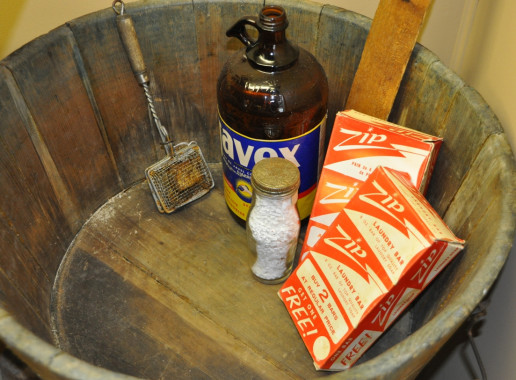Women.2.jpg

Wooden washtub, c.1890.
Wash day was an enormous task in the 19th century. It usually took an entire day interrupted only by meal preparations and child care. In the summer, the laundry was done outside and in the winter, down in the basement or in the kitchen. The preparations for wash day usually began a day ahead of time when clothes were soaked. On washday, the boiling soapy water had to be carried in buckets from the stove to where the washtubs were set. The clothes were put through two washings and stubborn dirt was rubbed out on a corrugated washboard. The clothes were transferred from one hot tub to another with a wooden fork. Items to be starched were dipped and rubbed with a solution so hot that hands had to be plunged into cold water to prevent scalding. Wash was done for the family and for hired farm hands as well. As the men worked in close contact with the soil and with animals, there was usually a large pile of extremely dirty clothing as well as socks, heavy under garments, flannel and woolle
Wash day was an enormous task in the 19th century. It usually took an entire day interrupted only by meal preparations and child care. In the summer, the laundry was done outside and in the winter, down in the basement or in the kitchen. The preparations for wash day usually began a day ahead of time when clothes were soaked. On washday, the boiling soapy water had to be carried in buckets from the stove to where the washtubs were set. The clothes were put through two washings and stubborn dirt was rubbed out on a corrugated washboard. The clothes were transferred from one hot tub to another with a wooden fork. Items to be starched were dipped and rubbed with a solution so hot that hands had to be plunged into cold water to prevent scalding. Wash was done for the family and for hired farm hands as well. As the men worked in close contact with the soil and with animals, there was usually a large pile of extremely dirty clothing as well as socks, heavy under garments, flannel and woolle